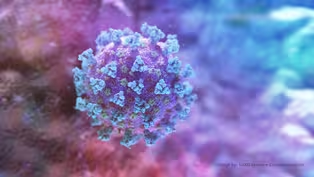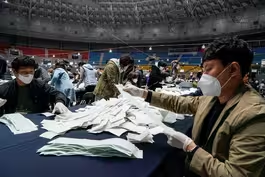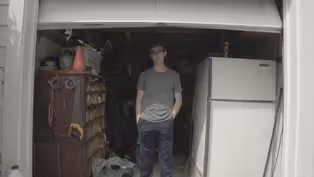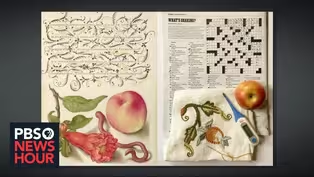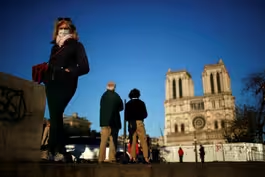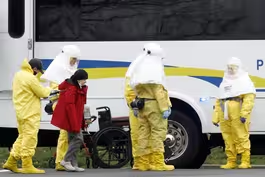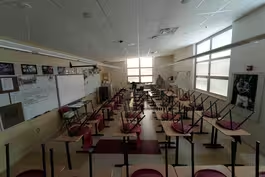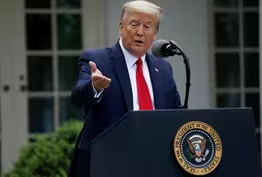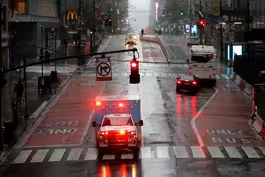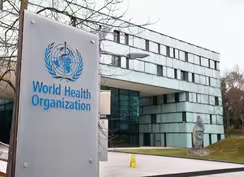
April 15, 2020 - PBS NewsHour full episode
4/15/2020 | 56m 53sVideo has Closed Captions
April 15, 2020 - PBS NewsHour full episode
April 15, 2020 - PBS NewsHour full episode
Problems playing video? | Closed Captioning Feedback
Problems playing video? | Closed Captioning Feedback
Major corporate funding for the PBS News Hour is provided by BDO, BNSF, Consumer Cellular, American Cruise Lines, and Raymond James. Funding for the PBS NewsHour Weekend is provided by...

April 15, 2020 - PBS NewsHour full episode
4/15/2020 | 56m 53sVideo has Closed Captions
April 15, 2020 - PBS NewsHour full episode
Problems playing video? | Closed Captioning Feedback
How to Watch PBS News Hour
PBS News Hour is available to stream on pbs.org and the free PBS App, available on iPhone, Apple TV, Android TV, Android smartphones, Amazon Fire TV, Amazon Fire Tablet, Roku, Samsung Smart TV, and Vizio.
Providing Support for PBS.org
Learn Moreabout PBS online sponsorshipJUDY WOODRUFF: Good evening.
I'm Judy Woodruff.
On the "NewsHour" tonight: The death toll in the U.S. from COVID-19 nearly doubles in a week, as President Trump concedes that the power to end social distancing lies with the governors.
Then: when to reopen.
As the White House pushes an aggressive restart of the economy, what will it take to get Americans back to work safely?
And on the front lines with nurses in the intensive care unit, amid mounting stress from treating the sick, and fears over the potential for contagion.
Plus: answering your questions about COVID-19, the risks of transmission, and how to stay healthy while caring for loved ones.
All that and more on tonight's "PBS NewsHour."
(BREAK) JUDY WOODRUFF: Debate is building at the White House and in statehouses tonight over when to cast off the curbs imposed by COVID-19.
It comes as the pandemic's U.S. death toll is at 28,000 and still rising, and as the economic damage deepens.
John Yang reports on the day's developments.
DONALD TRUMP, President of the United States: The plans to reopen the country are close to being finalized.
JOHN YANG: Despite President Trump's eagerness to lift restrictions, even as COVID-19 continues to claim lives, local officials are saying, not so fast.
At the American epicenter, New York City Mayor Bill de Blasio said today, the response needs to be purposeful.
BILL DE BLASIO (D), Mayor of New York: If you want to restart the economy, get it right.
Actually make sure that we have contained this thing.
JOHN YANG: New York Governor Andrew Cuomo said the state's health care system has not been overwhelmed, as initially feared.
but he said more testing is needed before restrictions are relaxed, and that the federal government needs to be involved.
GOV.
ANDREW CUOMO (D-NY): The states cannot develop national testing.
There is no simple answer to it.
It's basically controlled by private sector companies.
JOHN YANG: Cuomo also said he was taking the aggressive step of requiring all people to wear masks in public when they could not keep at least six feet away from each other.
Senate Democratic leader Chuck Schumer today called for a $30 billion nationwide testing program.
Mr. Trump has already formed a working group to rebuild the nation's economy.
The Great American Economic Revival Industry Group includes nearly 200 people spanning 16 industries, like former Secretary of State Condoleezza Rice, Apple CEO Tim Cook, NBA commissioner Adam Silver, and the AFL-CIO's Richard Trumka.
The president also announced Tuesday that the United States will suspend funding the World Health Organization, saying it pushed Chinese misinformation.
Today, the WHO's top official rejected that claim and called for cooperation.
TEDROS ADHANOM GHEBREYESUS, WHO Director General: This is a time for all of us to be united in our common struggle against a common threat.
JOHN YANG: The dispute comes amid fresh reports that the Chinese government withheld information in January, as coronavirus spread in Wuhan.
Today, a government spokesman pushed back: ZHAO LIJIAN, Chinese Foreign Ministry Spokesman (through translator): China has always timely notified the WHO and relevant countries of the epidemic information with an open, transparent and responsible attitude.
JOHN YANG: Meanwhile, cases of COVID-19 continue to increase across the United States, now representing a third of the more than two million cases worldwide.
Outside the Michigan state capital in Lansing today, a conservative group rallied against Democratic Governor Gretchen Whitmer's moves to close places like golf courses and landscaping companies, unless they adhere to social distancing guidelines.
Nationwide, the widespread economic damage is becoming clearer.
Retail sales dropped 8.7 percent in March, the steepest decline in nearly three decades of record-keeping.
While some Americans have begun seeing their $1,200 in stimulus money in their bank accounts, the Treasury Department now says 70 million paper checks will go out with President Trump's name on them, but officials say it will not delay the mailing.
Elsewhere, the start of a new normal.
HENRIK WILHELMSEN, Teacher: We have set the tables two meters apart.
We have soap, disinfectant all over the place.
JOHN YANG: In Denmark, schools have reopened for children 12 years old and younger if the schools meet government requirements, like keeping a 6.5-foot distance between children.
And parents are allowed to keep their kids at home.
Denmark was the first European country to shut down in early March.
And donning face masks and gloves, South Korean poll workers began counting ballots in this year's parliamentary elections.
Officials said turnout was higher than expected.
For the "PBS NewsHour," I'm John Yang.
JUDY WOODRUFF: And underscoring how far the U.S. may be from returning to normal, the mayor of Los Angeles said late today that the city is not likely to allow sporting events, concerts and other large events until next year.
In the day's other news, Wall Street swung lower again, as oil prices fell and banks warned of billions in loan defaults caused by the pandemic.
The Dow Jones industrial average dropped 445 points to close at 23504.
The Nasdaq lost 122 points, and the S&P 500 gave up 62.
California will make pandemic relief payments of $500 apiece to 150,000 migrants who are living in the state without documentation.
Democratic Governor Gavin Newsom said today that they do essential work and pay millions of dollars in taxes.
Almost 40 percent of the money will come from private contributions.
The migrants are not eligible for federal payments.
The world's 20 richest economies are freezing debt payments owned by poorer countries during the pandemic.
The G20 nations announced it today.
The moratorium covers payments totaling $20 billion.
It is aimed at helping African countries spend more on health care and vulnerable populations.
Today marked one year since fire gutted Notre Dame Cathedral in Paris.
But now COVID-19 has halted reconstruction work.
Plans to remove 250 tons of scaffolding have been delayed.
But French President Emmanuel Macron pledged again today that the huge project will be done on schedule.
EMMANUEL MACRON, French President (through translator): I promised we would rebuild Notre Dame within five years.
We will do everything we can to respect that delay.
The building work is, of course, at a halt at the moment because of the health crisis.
But it will resume as soon as possible.
JUDY WOODRUFF: Tonight, the giant bell in the church's south tower rang out, joining a nightly applause for health workers who are treating pandemic victims.
Back in this country, about 50 vehicles piled into each other on a Chicago expressway, after a winter storm left the road iced over.
At least 14 people were taken to hospitals from the scene.
Illinois State Police closed the expressway's southbound lanes for three hours to clean up.
And in the Democratic presidential campaign, Massachusetts Senator Elizabeth Warren endorsed former Vice President Joe Biden.
She was the last of his major rivals to do so.
Warren said that Biden will restore America's faith in good, effective government.
Still to come on the "NewsHour": President Trump threatens to pull funding from the World Health Organization -- what it would mean at a time of crisis; when to reopen and how to do it safely -- a conversation on restarting the American economy; on the front lines in the intensive care unit -- how nurses are handling the stress; to South Korea, where the government's response to COVID-19 may turn the tide of today's election; and much more.
President Trump said yesterday he would cut U.S. funding for the World Health Organization.
He accused the body of being too trusting of China's assertions that it had the virus under control.
Our Nick Schifrin joins me to discuss the dispute and the underlying facts.
So, hello, Nick.
What the president said is that he will freeze all funding to the World Health Organization.
What exactly would that look like?
NICK SCHIFRIN: Yes, I talked to senior administration officials about this, and they say that freeze is a 60-to-90-day freeze.
And the way it works, Judy, is that the U.S. which is the largest contributor to the WHO, doesn't cut a single check, so there are different WHO programs that get funded at different times.
So anything earmarked to the WHO over the next two to three months simply wouldn't get paid.
Now, here's the question.
Officials are considering whether to take that money and send it to another organization or send it directly to countries, instead of to the WHO.
Or they're going to freeze it and hold it, trying to use it as leverage, and that's what they say they're after.
They're trying to get leverage to reform the World Health Organization.
JUDY WOODRUFF: And so what kind of reforms are they looking for?
NICK SCHIFRIN: Judy, the short-term goal is very clear.
They want Taiwan to be an observer at the WHO again.
It was in the past.
China has resisted giving it back that status.
And U.S. officials tell me they believe the director general of the WHO can simply do that and decide that himself.
A second goal is to somehow force countries to share information about outbreaks.
Now, right now, they are required to share information to the WHO.
The U.S. officials say there's simply no enforcement mechanism in order to do that.
And the third goal is to kind of reorient the priorities of the World Health Organization.
WHO does a lot of things.
It worries about polio.
It does road safety.
It worries about local health emergencies.
But the U.S. wants it to focus almost exclusively on infectious disease.
JUDY WOODRUFF: And the WHO spoken in its own defense today.
What are they saying?
NICK SCHIFRIN: Yes.
The World Health Organization has said that it has to work with China, and it has to work within the confines of those regulations that require more self-reporting.
So, let's take a listen to Michael Ryan.
He's the director -- executive director of the WHO's emergency program.
DR. MICHAEL RYAN, World Health Organization: The international health regulations is a framework negotiated by 194 countries.
We simply implement that framework on behalf of our member states.
What we need in WHO, like so many workers around the world, is the space, the support and the solidarity to do our jobs.
NICK SCHIFRIN: And, of course, Judy, the administration today has been criticized for reducing that support and solidarity in a time of pandemic and because, in order to enact those reforms, it's going to need the support of the other members of the World Health Organization, other countries around the world.
JUDY WOODRUFF: And what sort of criticism, Nick, directed at the U.S.?
NICK SCHIFRIN: Yes, the criticism is everywhere.
You saw Bill Gates, whose foundation is a major funder of the WHO, say that cutting the WHO would be a bad choice, and -- quote - - "The WHO is slowing the spread of COVID-19.
And if that work is stopped, no organization can replace them.
The world needs WHO now, more than ever."
And Speaker of the House Nancy Pelosi said: "The president is ignoring global health experts, disregarding science and undermining the heroes fighting on the front line."
JUDY WOODRUFF: So that's praise, but that is in contrast to the administration criticizing the WHO for many months.
NICK SCHIFRIN: Yes, it's not only been the administration, but a lot of critics around the world have said simply that the WHO is too swayed by China.
And let me take you back to about New Year's.
This is the time when local doctors in Wuhan, China, were telling hospital administrators that, hey, this is something new, and there is human-to-human transmission because we're getting sick, but the hospitals and the local government covered that up, or at the very least silenced those local doctors.
So, on December 31, the Wuhan government released a statement: "The investigation so far has found no obvious person-to-person transmission, and no medical personnel have been infected."
And the WHO basically parroted that language.
January 5: "Based on the preliminary information from the Chinese investigation team, no evidence of significant human-to-human transmission, and no health care worker infections have been reported."
Officials who are talking to me say that the WHO should have known better and shouldn't have accepted Chinese language.
JUDY WOODRUFF: But, Nick, weren't the Trump administration and the WHO praising China's response back in -- back in January?
NICK SCHIFRIN: Yes, that's a great point.
And this is really key.
So let's take a listen to the director general of WHO talking in January, the day after the WHO declared this a global emergency, but also President Trump praising China.
TEDROS ADHANOM GHEBREYESUS, WHO Director General: WHO continues to have confidence in China's capacity to control the outbreak.
DONALD TRUMP, President of the United States: I spoke with President Xi.
We had a great talk.
He's working very hard.
I have to say, he's working very, very hard.
And if you can count on the reports coming out of China, that spread has gone down quite a bit.
NICK SCHIFRIN: And, Judy, obviously, the president's language about China has changed, and the U.S. really does want to reform WHO, but they need international support to do so.
And it's not clear that they have that.
JUDY WOODRUFF: Nick Schifrin, thank you so much.
All this background is incredibly important.
Thank you, Nick.
NICK SCHIFRIN: Thank you.
JUDY WOODRUFF: We return tonight to the question of how and when we might reopen the country, or big parts of it, and return to something closer to normal.
Former FDA Commissioner Dr. Mark McClellan has been working on a major road map to gradually reignite the economy.
But that reopening would happen only after several important milestones are reached.
Lawmakers and the White House are looking at the framework he proposed with former FDA Commissioner Scott Gottlieb.
Dr. McClellan served in the George W. Bush administration.
He is now director of the Duke-Margolis Center for Health Policy at Duke University.
Mark McClellan, welcome back to the "NewsHour."
It's so good to have you with us.
I think, understandably, Americans right now want to believe we are about to go back to normal within a matter of a few weeks.
But it's not going to be quick and it's not going to be simple, is it?
DR. MARK MCCLELLAN, Former FDA Commissioner: It's not.
We are doing a great job, our health care systems dealing with the surge in cases and Americans across the country taking important steps that have definitely slowed the spread of the virus.
So, we're getting past this initial surge, but this is really just the end of the beginning.
The virus is going to be with us for a while.
We can take steps to reopen our economy and get back toward normal, but it's going to be a new normal, and we need to put some real protections in place to harden our communities against the virus ever spreading like it has again.
JUDY WOODRUFF: And just as an example, social distancing is something people are going to be living with for a while.
DR. MARK MCCLELLAN: And maybe even more.
The steps that New York has recommended around wearing face coverings when you're in close quarters with other people, and steps in our businesses, in our schools to make it harder for the virus to be transmitted, we're going to see more of that in the months ahead.
JUDY WOODRUFF: Your report says that, in order for this economy to be reignited, so to speak, that there has to be serious and comprehensive rapid testing, ample testing around the country.
Tell -- give us a sense of what percentage of Americans would need to have this and how fast the results would have to come before we can talk about anything close to normal.
DR. MARK MCCLELLAN: Well, Judy, the goal here is to go from reacting to a spread of the virus that we really don't understand and haven't controlled well, except for these really extreme measures, to being able to identify any new outbreak very quickly, and then take local, right around it, steps to contain it before it spreads further.
And that means testing and tracing every case, if possible.
That's the goal.
So, that means diagnostic tests available quickly to everyone who might have symptoms that reflect COVID-19.
And that's respiratory symptoms, fever, things like that, as well as people who are working in environments where there's a high chance of transmission, like a nursing home, for example.
So we think that's on the order of a million tests or more per week across the United States, and it's not just having that many tests nationally.
It's being able to get them quickly to every community in the country, so that each community can keep the virus under control.
JUDY WOODRUFF: And how long is it going to take?
I mean, is it even possible to say at this point?
DR. MARK MCCLELLAN: Absolutely.
And this is what we should be building for right now.
It doesn't need to be that far off.
The test capacity in the United States today, which includes public health lab, hospital labs that have expanded, commercial labs that have expanded, and other point-of-care testing, with new testing mechanisms coming onto the market that can sometimes get test results quickly right into the community, that can meet this capacity.
But what we also need is the ability at the state and local level to make sure everyone has access and then also make sure that we have the test materials we need to go along with the tests themselves, like swabs for tests that need to be done through the nose.
We're working on new tests that can be done by spitting.
That will be easier to use.
JUDY WOODRUFF: But we know those things are not available right now, and it's going to take some time before they are where -- everywhere they need to be.
What about therapy for -- in addition to testing.
At what point -- and where are we in terms of coming up with a therapy that could be administered to people if they start to come down with coronavirus?
DR. MARK MCCLELLAN: There are some very promising antiviral treatments that are in clinical testing now, for example, the drug remdesivir from Gilead, that could be available within a matter of a couple of months.
There are other promising drugs that are already on the market or have been used for other purposes.
There are efforts under way at FDA to speed the development of those drugs.
And I think one additional step we could look at is going ahead with increasing their production, so that they can be available in large quantities to help really support these steps to reopening sooner, rather than later.
A vaccine is a little ways off.
But there too there are unprecedented efforts taking place, not only in the United States but in collaboration with other countries, to do large-scale clinical testing fast, to get manufacturing done fast, and hopefully to make vaccines available in the next year or less as well.
JUDY WOODRUFF: And that's the timeline we hear, that at least a year, or even a little beyond, before -- before there's a there's a vaccine that can be widely available, not just in this country, but around the world.
But there's also this -- what's so-called contact tracing, surveillance, being able to identify when people have been in touch with someone, who they -- who they have been in contact with, rather, who might have been infected.
We're hearing from the tech companies like Google and Apple.
They're trying to come up with an app.
But we know that's complicated, too, isn't it, Mark McClellan?
DR. MARK MCCLELLAN: It is.
But I think, once again, we can take some steps now to be ready for that surge in testing capacity that we're going to need in a matter of just a few weeks.
So steps to make those test supplies more widely available, that's something that the government can be working on with the private sector now.
And in terms of doing contact tracing, that is going to take more people.
But this is a great area for further federal support to put those people in place, working with mayors, working with governors, to ramp up the ability to track down people who may have been in contact, in close contact, with people who test positive.
JUDY WOODRUFF: So, Mark McClellan, when you look at all the things that are needed, we're talking about several months.
We're not just talking about next month, May or June, are we?
DR. MARK MCCLELLAN: Well, I think it depends on how fast areas can put together these capabilities and how hard-hit they are now.
Many areas of the country have been lucky.
They haven't had very many cases.
So, for them, it will be relatively easy to put in place testing and tracking.
It is not going to take as many people, not going to take as much resources.
Still very important.
People there are still vulnerable to the virus, but it could happen quickly.
And throughout the country, I think this is going to happen in a stepwise fashion, with maybe some limited reopening first.
Schools should be a priority, businesses that can make the steps to harden their ability to resist infection transmission.
So, I think you will see progress within the next month, but it will happen at different paces across the country.
And it really depends on getting these key capabilities in place to give people confidence they can go out and get back towards normal without risk of contracting the virus.
JUDY WOODRUFF: Mark McClellan, we hope to - - we certainly do hope to stay in touch with you as progress is made in this direction that everybody so badly wants.
Thank you very much.
DR. MARK MCCLELLAN: Thank you very much.
JUDY WOODRUFF: While some states do appear to be hitting a plateau with COVID-19, others, like Florida, are seeing their cases grow.
This week, the state's surgeon general said that residents may need to wear masks in public for up to a year, until a vaccine is rolled out.
William Brangham spoke with Joseph Falise - - he's a nurse at the University of Miami Health System -- about what health care workers are facing.
They started by focusing on the practical difficulties of treating patients while wearing so much protective gear.
WILLIAM BRANGHAM: For people who are not familiar with the process of just putting on all of that protective gear in order to be safe going into care for patients, could you walk us through what that is like physically?
JOSEPH FALISE, ICU Nurse Manager, University of Miami Health System: I think that the main difference between now and prior to COVID is that it's palpable, the sense of urgency with which we need to protect ourselves.
And, if we don't, what will be the outcome?
We have heard of, you know, health care workers who have gotten sick.
We have heard of health care workers that are dying, and some even in our own local community.
And we know that we are not immune to this and that, if we're not careful and if we don't hold each other accountable, that we will get sick.
So we have a very heightened sense of awareness and a very heightened sense of, you know, compliance with our current protocols.
WILLIAM BRANGHAM: I understand that, when someone is going through the process of putting on all of that gear, you assign someone else to watch them to sort of guide them through that process.
Can you explain why you do that?
JOSEPH FALISE: We kind of took a page out of the aviation industry.
We know that when you work off of checklists, things get done much more consistently.
So, we developed a checklist of how to put on the gear, so that no stuff gets missed.
And, similarly, we made a checklist of how to take off the gear.
It's well known that the most vulnerable, most risky part of putting -- of this whole process is what we call doffing the equipment, taking the equipment off.
We have been in rooms with patients who have COVID, and we know that the outer PPE is contaminated.
So we want to protect ourselves from having any contact with that virus.
So, we have developed a process where we have an observer who both watches us put on our gear.
And then, also, we don't allow ourselves to take off the gear unless we have an observer watching us.
And there's also that absolute awareness that, if we're not extremely careful, you will get sick.
WILLIAM BRANGHAM: I understand the job is physically exhausting, but to go through that, both trying to deliver wonderful care to people who are themselves very, very sick, at the same time being so worried about your own health, that has got to be a lot to bear day in and day out.
JOSEPH FALISE: Yes, I think that's the hardest part.
The hardest part is the mental exhaustion.
We're fortunate right now that we're not understaffed, though the stressor becomes, how do I take care of these patients with all of this gear on, knowing that putting personal protective equipment on will restrict the way that I take care of patients?
But, also, how do I work within this gear and protect myself from all the viruses that are out there?
So, it is mentally exhausting, absolutely, no doubt about it.
And we have nurses that are staying in these rooms for hours at a time.
WILLIAM BRANGHAM: Hours at a time?
JOSEPH FALISE: Yes.
Sometimes, they stay in there for hours at a time.
But we have to be there to monitor those machines, address any alarms that may go off, change I.V.
fluid bags.
You know, most of these patients are 10 -- and have been on six or seven or eight infusions.
It takes a lot of monitoring to make sure that none of these tubes come out, that all of the infusions are running, and that the bags don't run out.
The gear that we wear, you know, the bunny suit and the outer gown, it's very hot inside, extremely hot inside.
And if the nurse stays in there for a couple of hours, yes, the evidence is, when they come out, they look like they are completely drenched in sweat.
And it -- not one single person is immune to it.
WILLIAM BRANGHAM: I don't think people appreciate just the physical taxation of what you're doing, on top of the mental taxation.
JOSEPH FALISE: Yes.
You know, when I go back into the isolation units, and I'm in patient rooms, it's a different - - it's -- and I have been an ICU nurse for a long time.
If I was to imagine what a war zone would be like, that -- I feel like that's what it would be like, because it doesn't matter what room you walk in.
You feel the same sense of -- I don't know.
You just feel the same sense of, this is a really sick patient, and what can I do to help this patient get back to their family?
WILLIAM BRANGHAM: You're obviously seeing this pandemic in a way that very few Americans get to see.
And out here, outside of this front-line work that you all are doing, there's this constant debate about, are these restrictions too much?
Should people stay at home more?
Should we reopen the economy?
Do you have anything to say to people who don't get to see this pandemic the way you do, about that debate?
JOSEPH FALISE: I think probably my most important message would be, nobody is immune to this.
And the only way that has been proven to stop the spread of this is through distancing, is through staying home.
These things have been proven to work.
And we have known this for many, many, many years.
But it's hard to do.
And I understand that.
I think my most important message would be, it could happen to you.
As somebody who's seeing it day in and day out and dealing with families who really are heartbroken and who really are just -- their lives are shattered because they're losing their family members, and their family members are having to die without them, and we do our best to try to ease some of that suffering by FaceTiming and by promising to be there as a surrogate.
But the reality is, it could be you next.
You have an option.
That's my main point.
WILLIAM BRANGHAM: All right.
Joseph Falise, clinical nurse manager at the University of Miami Health System, thank you very much.
And good luck in all your work.
JOSEPH FALISE: Thank you very much.
Thank you for bringing this up.
JUDY WOODRUFF: South Korea has turned from a COVID-19 hot zone to a leader in the global fight against the new coronavirus.
Companies there are now making millions of virus test kits for export, and the public is voting in a parliamentary election, despite the epidemic.
Correspondent Bruce Harrison reports from Seoul on how the Koreans have worked together to get this far and aim to prevent a resurgence of the virus.
BRUCE HARRISON: To visit this factory, you can't risk contaminating the product.
The work going on behind this door may just save your life.
Manufacturer Bak Jin-Wook (ph) says they're putting chemical agents into vials and sealing the lids.
The assembly line at South Korean firm Gencurix is small.
But the chemicals they're packaging just today can be used in up to 150,000 COVID-19 tests.
This is the final product.
SANGRAE CHO, Gencurix (through translator): Each of these kits can be used to test up to 100 people.
A sample is collected from the patient's nose or mouth.
A method called PCR is used to confirm the diagnosis, which takes three to four hours.
BRUCE HARRISON: The company jumped into action, researching test kits in this lab in January when it heard about the first coronavirus death in Wuhan.
South Korea learned the importance of early diagnosis during the 2015 outbreak of Middle East Respiratory Syndrome, or MERS, a viral respiratory illness similar to COVID-19.
In theory, the faster you test, the faster you're able to isolate infected people and stem the spread of the virus.
The government worked with Gencurix and other companies this year to produce test kits, so they could quickly receive regulatory approval to test Koreans.
HYUN PARK, Gencurix: Although we are not doctors or nurses, we feel that we are also fighting coronaviruses.
So, we feel it's very important in the world, although it's a good business opportunity for us.
But it's a very sad situation.
BRUCE HARRISON: South Korea ran a textbook response to COVID-19 and has tested nearly 530,000 people.
More than 10,500 have tested positive, and 222 have died, for a death rate of just over 2 percent, half that of the United States.
With no shortage of kits here, Gencurix is exporting tens of thousands all over the world.
It plans to boost that number and send many to the U.S. once it receives FDA approval.
South Korea's success at home against COVID-19, and its international reputation as a leader in battling the pandemic, have given a boost to President Moon Jae-in.
And it may have come at just the right time, with today's parliamentary election.
Moon has shouldered much of the blame for Korea's slowing economy.
But the government's COVID-19 response may help extend his party's majority in Parliament.
Moon has made election safety a top priority.
People had to have their temperature taken and wear rubber gloves and masks to vote.
Lines were marked to keep voters at least three feet apart, and quarantined citizens could only leave home for a short time to vote after the polls had first closed for the rest of the public.
But it'll take more than a safe election to prevent a resurgence of COVID-19.
In this low-income neighborhood, professionals from the Korean Pest Control Association always announce their arrival.
And the goal is to be as swift and nondisruptive as possible.
They pay for the supplies and disinfectant out of pocket.
This volunteer says the residents have very little money, so groups like his disinfect the building to keep it safe.
Dozens of residents here share a single kitchen or bathroom, but it's still outbreak-free.
IM JAE-CHUL, South Korea (through translator): These people lack medical care, and most of them are marginalized and lonely.
Personally, I'm thankful that some people are still concerned about us.
BRUCE HARRISON: Residents can also get free face masks at a nearby community center.
Center director Bae Il Hwan (ph) explains to a resident she will need to throw out her disposable mask if she wears it several times.
But she can always come back for a new one.
Seoul has extended a social distancing campaign through the end of the week.
The government wants the public to stay home, aside from going to work, visiting a doctor or buying necessities.
In the early weeks of the outbreak here, most people tried to stay home, but that's now proving challenging.
There is no lockdown or even a shelter-in-place order, but the government does have its concerns, for one, these beautiful cherry blossoms.
It's the spring flowers and the warm weather in general that are drawing people out in very large numbers, threatening the success of social distancing.
Seoul nightlife is also making a comeback.
Some bars in this neighborhood shut down, but only temporarily.
Others are operating at a loss, even with improved traffic.
IM SOO JIN, Bar Manager (through translator): We have great preventive measures and a health care system to back us up.
Of course, everyone's health is the most important issue, but we have to go on with our lives.
BRUCE HARRISON: And that may be easier, as Im suggests, in a country with single-payer health care that she seems to trust, as perhaps her patrons do as well.
And nothing quite marks spring in Seoul like a picnic by the Han River.
Like the election, there are precautions here, from signs urging people to keep their distance and bottles of free hand sanitizer.
But, unlike the election, there doesn't appear to be any enforcement.
WOO CHAN, University Student: The convenience store, like, we were just in there.
The line is huge.
And that's probably not a good thing if you want to practice social distancing.
BRUCE HARRISON: The growing trash heap near the store says a lot, namely, Seoul is ready to get back to normal.
But it's also a sign the people are confident their efforts and those of the government have made it possible this soon.
For the "PBS NewsHour," I'm Bruce Harrison in Seoul.
JUDY WOODRUFF: During these difficult times, we all have questions.
And, tonight, we begin a new weekly segment, Ask Us.
We want you to submit your questions via our Web site and our various social media platforms, Twitter, Instagram and Facebook.
For the record, Facebook is a funder of the "NewsHour."
Amna Nawaz brings us some answers.
AMNA NAWAZ: Thanks, Judy.
And thanks to all of you for sending us your questions.
We want to answer as many as we can.
And, for that, I'm joined today by Dr. Ranit Mishori.
She is professor of family medicine at Georgetown University School of Medicine and senior medical adviser for Physicians for Human Rights.
Welcome, and thanks for being here, Dr. Mishori.
DR. RANIT MISHORI, Georgetown University School of Medicine: Thank you so much for having me.
AMNA NAWAZ: So, I want to get to as many questions as we can.
Let's jump right in.
The first one comes to us from Ingrid in California.
She submitted her question via Instagram.
Here's what she has to say: INGRID ECHEVERRIA, California: Do you have to go through complete decontamination routine every time you go out?
I understand washing your hands, cleaning the doorknob, your keys, et cetera.
But do you have to wash your clothes, take a shower each time we come back from the store?
AMNA NAWAZ: What do you say to Ingrid?
How careful do you have to be?
DR. RANIT MISHORI: Well, you have to try to be as careful as possible.
But I think you don't have to do all of that every time you step outside of the house.
The key is that this virus is transmitted by being around other people.
So, if you have to go to work, if you're an essential worker, and you work with a lot of people, you work at a store, or you're a health care professional, yes, when you come home, take your clothes off, put them in the wash, jump in the shower.
But if you go for a walk around the block or going to get groceries, you obviously have to wash your hands.
You have to make sure that, when you do go out, wear a mask to protect others.
But showering and putting your clothes in the washer every time you step outside of the house, that's not necessary.
AMNA NAWAZ: Here's another question about what's safe or not safe to do.
This one comes to us from Clare Sullivan in Wisconsin.
She submitted her question on Facebook.
And she writes: "I'm 67 years old.
I still go to my son's house five mornings a week to help care for his baby.
Both parents are working from home.
Is this safe?"
What do you say, Dr. Mishori?
DR. RANIT MISHORI: If you can stay home, stay home.
If you don't have to take public transportation, do not take public transportation.
Try to be as safe as possible.
AMNA NAWAZ: So, even if you're going to a family member's house, that's the only place you're going, caring for a grandchild, still wear a mask, take all those precautions, if you can?
DR. RANIT MISHORI: Absolutely.
Take as many precautions as possible.
And understand that, if you're around other people, you may get the virus and you may transmit it to people you come in contact with.
And, as I said, the ideal situation would be for you to stay home and not go out at all, unless it's absolutely necessary.
AMNA NAWAZ: Let's hear now from Jason Fuller.
He submitted a video question via Instagram to us.
Here's what he has to say: JASON FULLER, New Jersey: My question is, for those who are experiencing mild symptoms, is there any particular self-care regimen that they should be doing?
AMNA NAWAZ: Mild symptoms, we know a lot of people have them.
What do you say to Jason?
DR. RANIT MISHORI: Yes, so, a lot of people have them, and we tell them to stay home, which is exactly what he's doing.
The question is, what do you do at home?
The coronavirus, some of the symptoms, when they're milder, are like any other viral symptom -- viral infection.
So, you would get some rest.
You would drink a lot of water.
You can take over-the-counter medications to help with pain, to help with a fever.
But the key is, if you have the coronavirus infection, you want to isolate yourself at home.
So you want to, ideally, if it's possible, to have your own room, to have your own bathroom, not to eat with other family members, to try and keep yourself in isolation.
AMNA NAWAZ: We want to go to Jennifer Thomas.
She submitted a video question via Facebook.
And she wants to know about what happens if you catch the virus and recover.
Here's her question: JENNIFER THOMAS, Texas: If a person is officially declared recovered from COVID-19, can that person be an asymptomatic carrier of the virus later, if exposed again?
AMNA NAWAZ: It's a great question.
Dr. Mishori.
If you're sick, you recover, can you still pass the virus onto other people?
DR. RANIT MISHORI: This is one of these excellent questions that we don't have an answer to just yet.
At this point, what we know is that there's some very preliminary studies from China and from Korea showing that some people potentially can get reinfected after they have recovered.
And then, if they can get reinfected, they can also infect others, potentially.
There's a very big question mark about this.
We also know that there are infections from asymptomatic people.
So, I think, at this point, we don't have an answer for that.
AMNA NAWAZ: Still so much we don't know.
I do want to move on to a question from Mary Liz Towne.
She wrote in on our "PBS NewsHour" Web site with a question specific to her family.
She asks: "When will it be safe for my 83-year-old mom with underlying health issues and cognitive decline to leave her apartment?"
DR. RANIT MISHORI: I think one of the issues is, the vaccine is probably not going to be available for another year, year-and-a-half.
So, for now, stay home.
Later on, hopefully, May, June, July -- the models differ in terms of when the peak is going to take place in different cities and different states in the United States.
So we have to be patient and wait, hopefully, not a year or year-and-a-half.
Sooner.
AMNA NAWAZ: Hopefully not.
One last question before we let you go, Dr. Mishori.
This one comes to us from Janet.
She's in New Mexico.
She sent in a video on Facebook.
Here's Janet's question now: JANET WARNER, New Mexico: What is the permanent damage done to the lungs and heart by the virus?
AMNA NAWAZ: Dr. Mishori, do we know what the long-term effects will be?
DR. RANIT MISHORI: We're just beginning to find out, because we have the groups of people who are just recovering from very severe disease.
What we do know is that the virus itself or the inflammatory reaction that is caused by the virus can cause damage and irritation to the lining of the lungs.
Similarly, with heart disease related to COVID-19, we are now discovering that the virus or the inflammatory reaction is causing damage to the muscle itself.
What's important to know is, for people who have been in the ICU or have been ventilated for days or weeks, their recovery, regardless of long-term damage to the lungs or long-term damage to the heart, is going to be very long.
AMNA NAWAZ: We are learning so much more every day.
Dr. Ranit Mishori, thank you so much for taking some of these questions and providing answers today.
DR. RANIT MISHORI: Thank you so much.
I appreciate it.
AMNA NAWAZ: And thanks to all of you for your questions.
You can keep sending us more via "NewsHour"'s Twitter, Facebook and Instagram accounts, or on our Web site.
That's PBS.org/NewsHour.
JUDY WOODRUFF: We check in again on the latest from the White House on the government's response to this pandemic.
Our Yamiche Alcindor is with me now.
Yamiche, you have been at the briefing.
Tell us what you have been hearing.
YAMICHE ALCINDOR: Well, the big thing President Trump said today is that he is planning on announcing new guidelines for how to reopen some parts of the country tomorrow.
So, the big news is coming tomorrow.
He said that what the White House has been looking at, that they think they have passed the peak of this, and there are -- there's been a lot of progresses in cities like Houston, New York, New Orleans.
And he said that those numbers and that evidence is allowing him to say that some states might even be able to open before May 1.
But the president is basically saying that he is ready to reopen parts of this government by May 1, and that, tomorrow, we're really just going to hear about the procedures to do that.
Now, there's a lot of back and forth about whether or not that's going to be a good idea.
Critics of the president say he might be jumping the gun.
But the president seems very confident and that he wants to make that decision.
JUDY WOODRUFF: And just to clarify, Yamiche, the president is saying that the country has reached the peak and is now on the downslope?
YAMICHE ALCINDOR: That's right.
He's saying that the country as a whole has reached the peak.
Even though there are, of course, some parts of the country that are still struggling, he says that, overall, the country is doing much better and that we have passed the apex of this coronavirus crisis.
JUDY WOODRUFF: And we know also, Yamiche, the president has announced a big -- essentially a pretty large council, a group of people who are working with him to reopen the country, get businesses going again.
What were they saying about that today?
YAMICHE ALCINDOR: Well, the president announced a very long list of people that are going to be part of this White House task force to looking at reopening the government.
And he said that those leaders are going to be helping him think about which parts of the economy can be reopened and how to do that.
Now, today, we heard that, on a call with business leaders, those business leaders were telling the president that much more testing needs to be done in order to open large parts of the government.
We're also hearing that there are executives who didn't know that their names would be on the list of people to be part of this task force until after the White House announced their names.
So there are some people that are saying this is a chaotic task force and that this is being rolled out too swiftly.
But the president is still adamant that he understands the way that this should work and the way it's going to work.
So tomorrow is going to be a big day.
Another thing that I want to say -- it's a bit of a hard turn here, Judy, but the president was also railing against the idea that he's trying to push for some confirmations through the Senate, and that they're not being confirmed because Congress and the Senate in particular are out on recess.
So, the president is also saying that he might push to adjourn Congress in order to get those nominations done.
From what we can tell here at the "NewsHour," he can't actually do that.
There was a Supreme Court ruling during the Obama administration that said that that wasn't possible.
The other thing is that he said that he had confirmed some 448 judicial nominees.
That's not accurate.
The president has confirmed about 193 judges.
So, that's about 200 less than what he was talking about today.
So, apart from the fact that we're talking about this council, there was that -- also that other piece of news.
JUDY WOODRUFF: And very quickly, finally, Yamiche, reporting that the president wanted his name on the checks that are going to people as part of the relief from this pandemic, what was said about that?
YAMICHE ALCINDOR: Well, there were reports that the president pushed to get his name added to these stimulus checks that Americans are going to get, about $1,200.
We have been reporting about it.
And his signature is going to end in -- end up in the memo section, because he's not legally authorized to sign the checks.
But this is a big break in protocol.
The president was just asked about that on the White House lawn.
He's still speaking as we speak.
He's in the Rose Garden.
And he said that he had no parts in that and that he didn't ask for his signature to be done or to be put on to those checks.
But there are people, especially critics of the president, who say he's doing this to try to brand himself and to try to make it so that Americans think that he's the one who's giving them the checks personally.
JUDY WOODRUFF: Yamiche Alcindor, reporting on today's White House briefing.
Yamiche, thank you.
YAMICHE ALCINDOR: Thanks.
JUDY WOODRUFF: And now some homegrown creativity.
Jeffrey Brown looks at a social media challenge that is drawing responses from around the world, with everyday shelter-in-place life imitating art.
Its part of our ongoing arts and culture series, Canvas.
JEFFREY BROWN: There are no selfies being taken with the Mona Lisa right now.
We captured this scene at the Louvre last year during the blockbuster Leonardo da Vinci exhibition.
Instead, a new kind of selfie with art is making its way through social media, an updated version of Grant Wood's American Gothic.
A dad and his home-from-school children in a loose version of a 17th century Italian painting titled Lot and His Daughters.
Appropriate to the-moment screams.
The current call for recreating a work of art at home seems to have begun with a Dutch Instagram account called, in translation, Between Art and Quarantine.
It was picked up by others, including the world-renowned Rijksmuseum in Amsterdam, celebrated for its Rembrandt collection.
The result, playful recreations of old masters' paintings.
In Los Angeles, The Getty started #GettyMuseumchallenge, inviting people to use digitized and downloadable artworks.
Annelisa Stephan is The Getty's assistant director of digital content: ANNELISA STEPHAN, J. Paul Getty Trust: I have seen people connecting, total strangers connecting through this experience, cheering each other and liking and commenting and favoriting their favorite creations.
I also think art has a role to play in helping us make sense of this strange time.
I thought maybe we'd be lucky if we got 30.
That would sort of -- that would have been a big success.
And I feel like we got probably closer to 30,000, maybe more.
So, totally surprised.
JEFFREY BROWN: Andy Warhol's soup cans get an update to toilet paper.
A man stuck at home dreams of Napoleonic conquest.
ANNELISA STEPHAN: A favorite is a Renaissance manuscript page, and the artist added a thermometer into the composition.
And she had been recovering from pneumonia at the time.
So this kind of sadness of where we are today can coexist with the joy of being creative and seeing other people be creative in a really lovely way.
JEFFREY BROWN: Among the clear favorites for social distancing art lovers, pets in all kinds of poses and costumes, and the work of 17th century Dutch painter Johannes Vermeer.
Sometimes, as in pug with a pearl earring, pet and painter come together.
Another favorite, Mexican artist Frida Kahlo.
One mother made her own version of Kahlo's self-portrait with monkeys.
Alana Archer turned to household cleaning products.
ALANA ARCHER, Artist: I think everyone's been I was looking specifically for just kind of a strong portrait of a woman, and her painting was just striking to me.
And it just -- there was a sense of empowerment in it that I really enjoyed.
JEFFREY BROWN: The challenge is just one among numerous efforts museums everywhere are making to connect with absent visitors.
Many are offering virtual tours of their collections.
And while it's not the same as being in the museum and standing in front of a great work of art, this challenge is clearly connecting people to art in new and creative ways, and offering the rest of us a smile in the process.
For the "PBS NewsHour," I'm Jeffrey Brown.
JUDY WOODRUFF: By now, schools have been shuttered for weeks across the country.
It can be hard on parents to help orchestrate remote learning.
And shelter-in-place presents its own challenges for young people.
"NewsHour"'s Student Reporting Labs -- that's our journalism training program for high school students -- shares some ways that teenagers are coping in the age of quarantine.
COLE FLETCHALL-SILVA, Student: Me and many other Americans have been living on lockdown.
And during this time, we have been committing ourselves to a pretty strict routine of waking up at a reasonable time, running so I get some Vitamin D, eating, doing homework, eating again, doing more homework.
CLARE JONES, Student: I have learned to engage with my parents a little bit more, playing Scrabble and binge-watching television shows.
STUDENT: During this whole time, my teachers have been really flexible, especially with the amount of work they give.
Honestly, I miss the classroom atmosphere.
It's sometimes hard to stay motivated when you're at home with all of these other distractions around you.
BENJAMIN CURE, Student: This is kind of my setup.
We're required to document it for our video log for today.
So, pretty much what I'm doing is, I have this little desk set up here in front of my TV.
It has my homework, my folders, and I kind of do that while watching the TV to kind of keep myself updated with the news for the day.
SALMA VALENZUELA, Student: Honestly, I'm very upset.
The coronavirus really affected me because it took away my senior year, and I have just been trying to push through.
PATRICK HUNTER, Student: Due to this outbreak, I won't be able to run track to compete.
So, I started working out myself.
I like to look on the bright side of things by trying to go out for a nice jog once in a while and keep myself fit, not losing my endurance.
STUDENT: I can't see my friends, but that's OK, because technology is great, and we have Xbox Live and FaceTime.
ISABELLE MESROPIAN, Student: Although social distancing is hard, and it can be very frustrating staying inside every day, all day, these are necessary precautions.
So, hopefully soon,everything will get figured out and everything will go back to normal.
KAT GONZALEZ, Student: Overall, I'm taking this really seriously, and I hope that others are too, so we can get back into the swing of things.
PATRICK HUNTER: That's all it for me.
Thank you guys for tuning in, and stay safe.
ISABELLE MESROPIAN: Thanks for hanging out with me today.
COLE FLETCHALL-SILVA: Just keep in mind that everyone else is as worried and confused as you are.
What I mean is that you're not alone.
Stay inside and stay safe.
JUDY WOODRUFF: Thank you all.
That was just what we needed to hear tonight.
Thank you, Student Reporting Labs.
And that is the "NewsHour" for tonight.
I'm Judy Woodruff.
Join us online and again here tomorrow evening, when I will have an interview with Vice President Mike Pence.
For all of us at the "PBS NewsHour," thank you, please stay safe, and we will see you soon.
A doctor answers viewer questions about COVID-19
Video has Closed Captions
Clip: 4/15/2020 | 6m 43s | A doctor answers viewer questions about COVID-19 (6m 43s)
How South Korea became a global leader in pandemic response
Video has Closed Captions
Clip: 4/15/2020 | 6m 20s | Working together, South Koreans turn COVID-19 hot zone into containment leader (6m 20s)
How these teenagers are coping with social distancing
Video has Closed Captions
Clip: 4/15/2020 | 2m 9s | 'You're not alone': How teenagers are dealing with social distancing (2m 9s)
In this quarantine art challenge, creativity begins at home
Video has Closed Captions
Clip: 4/15/2020 | 3m 38s | In this quarantine art challenge, creativity begins at home (3m 38s)
News Wrap: Notre Dame Cathedral marks 1 year since fire
Video has Closed Captions
Clip: 4/15/2020 | 3m 17s | News Wrap: Notre Dame Cathedral marks 1 year since devastating fire (3m 17s)
Preparing to care for COVID-19 patients takes physical toll
Video has Closed Captions
Clip: 4/15/2020 | 6m 38s | The intense physical and mental effort required by health care workers amid COVID-19 (6m 38s)
Testing, treatment progress key to resuming American life
Video has Closed Captions
Clip: 4/15/2020 | 8m 13s | Progress on COVID-19 testing, treatments critical to resuming American life (8m 13s)
Trump says he’s confident U.S. is past the peak of COVID-19
Video has Closed Captions
Clip: 4/15/2020 | 4m 10s | Trump says he’s confident U.S. is past the peak of COVID-19 (4m 10s)
Trump says working groups planning U.S. economic resurgence
Video has Closed Captions
Clip: 4/15/2020 | 4m 39s | As U.S. death toll climbs, Trump says working groups are planning economic resurgence (4m 39s)
Where fragile hygiene and health care raise COVID-19 risks
Clip: 4/15/2020 | 3m 49s | Developing countries' fragile hygiene and health care raise COVID-19 risks (3m 49s)
Why Trump is criticizing WHO's pandemic response
Video has Closed Captions
Clip: 4/15/2020 | 5m 50s | What's behind Trump's criticism of the World Health Organization (5m 50s)
Providing Support for PBS.org
Learn Moreabout PBS online sponsorshipSupport for PBS provided by:
Major corporate funding for the PBS News Hour is provided by BDO, BNSF, Consumer Cellular, American Cruise Lines, and Raymond James. Funding for the PBS NewsHour Weekend is provided by...
